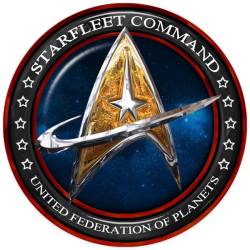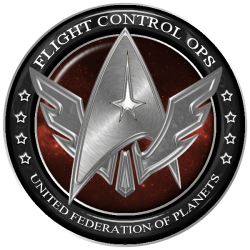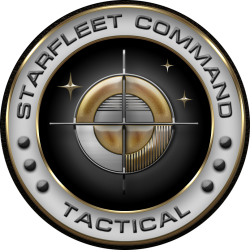Command Division: Difference between revisions
From Star Trek: Theurgy Wiki
Auctor Lucan (talk | contribs) No edit summary |
Auctor Lucan (talk | contribs) |
||
| Line 18: | Line 18: | ||
[[File:Tactical.png|250px|right]]This department was in charge of the ship's weapon systems, their calibrations and upkeep. Furthermore, the tactical officers on starships and starbases were, basically, the ones firing the weapons at the tactical station on the bridge. This role could sometimes be filled by the Chief of [[Security]] depending on the officer's experience and responsibilities on the ship. | [[File:Tactical.png|250px|right]]This department was in charge of the ship's weapon systems, their calibrations and upkeep. Furthermore, the tactical officers on starships and starbases were, basically, the ones firing the weapons at the tactical station on the bridge. This role could sometimes be filled by the Chief of [[Security]] depending on the officer's experience and responsibilities on the ship. | ||
Tactical officers were men selected from the Academy on account of superior intelligence, reliability and mechanical knowledge. The assignment to Tacical was made with the idea that the officers should be somewhat higher in standard than other officers in regard to starship weaponry and their usage; that their knowledge of ordnance and targeting should be such that they would be able to | Tactical officers were men selected from the Academy on account of superior intelligence, reliability and mechanical knowledge. The assignment to Tacical was made with the idea that the officers should be somewhat higher in standard than other officers in regard to starship weaponry and their usage; that their knowledge of ordnance and targeting should be such that they would be able to also make repairs to the systems. | ||
== MVAM Procedure Transcript == | == MVAM Procedure Transcript == | ||
Revision as of 20:16, 6 December 2018
The Command Division was the corps of officers and crewmen within Starfleet who specialized in command and control functions on starbases, aboard starships, and at Starfleet Command. Members of the command division were trained in leadership and had tactical training allowing them to decisively take action in organizing and mobilizing Starfleet crews to perform missions.
Command officers included most all of the admiralty, captains, executive officers, adjutants, pilots, and CONN officers (flight controllers/helmsmen). Command division personnel also filled posts as tactical officers and sometimes in ordnance departments. [Source: Memory Alpha]
Command
This department was reserved for the ship's Commanding Officer, Executive Officer, Second Officer, and Third Officer. These three were responsible for handing out orders to the rest of the departments in order to keep the ship running. Command covered a wide range of interpersonal interactions, especially leadership, negotiation, and both coordinating and motivating others. It also included discipline and resisting coercion, as well as helping others resist fear and panic.
These officers had to be able to carefully and precisely coordinate a group of subordinates, or to give detailed orders. They were also daring, making a split-second command decision, or - as earlier mentioned - resisting fear or coercion. They also had to judge the mood and morale of a group of subordinates, or to try and assuage the fears of a group, to rally or inspire others during a difficult situation, or to command the attention or respect of someone hostile. They also had to use reasoning, to consider and evaluate the orders given by a superior, or to find a solution to a difficult diplomatic or legal situation.
CONN
This was the ship's helm department, which was in charge of handling all flight operations on and off the ship. This meant the Theurgy and all of its support vehicles or any vehicles flying within its vicinity. Instead of the Tactical CONN department flying fighters, the CONN officers operated the shuttles. The Chief CONN Officer would work very closely with the ship's Chief Operations Officer with respect to the use of the ship's shuttle bays, since the Chief CONN Officer was responsible for the pilots flying the shuttles and for training shuttle pilots. Instead of Fighter Bay Ops handling the fighters, the regular Operations personnel - that answered to the Chief Operations Officer - handled the upkeep of the shuttles. Fighter Bay Ops belonged to the Operations department too, they were just specialised at warp fighters, but could be rotated to handle shuttles as well as required.
An officer's ability at the CONN covered piloting craft of all sizes, from ground vehicles and shuttles, to grand starships. It also included navigation — both on the ground and in space — and an understanding of starship operations, including the procedures and cultures of space travel and exploration. they had to be able to direct a starship or other vessel through a difficult environment, or to operate a craft with such precision as to aid someone else’s activities. They had to direct a starship or other vessel to avoid a sudden and imminent danger, or to perform extreme or unorthodox maneuvers with a craft using “feel” or “instinct”. They also had to be quick and effective in getting into an EVA suit, including moving through zero-gravity, or resisting the deleterious effects of extreme acceleration or unpredictable motion without an Inertial Dampening Field.
These officers were also experts in juding the nature or intent of another vessel by the way it is moving, or determining the source of a problem with a familiar vessel. They also had to maintain professional decorum and etiquette when representing your ship or Starfleet in formal circumstances, or to argue effectively over a matter of starship protocol, or a course of action.
Tactical
This department was in charge of the ship's weapon systems, their calibrations and upkeep. Furthermore, the tactical officers on starships and starbases were, basically, the ones firing the weapons at the tactical station on the bridge. This role could sometimes be filled by the Chief of Security depending on the officer's experience and responsibilities on the ship.
Tactical officers were men selected from the Academy on account of superior intelligence, reliability and mechanical knowledge. The assignment to Tacical was made with the idea that the officers should be somewhat higher in standard than other officers in regard to starship weaponry and their usage; that their knowledge of ordnance and targeting should be such that they would be able to also make repairs to the systems.
MVAM Procedure Transcript
For when MVAM is executed via computer and not by use of the auxiliary Battle Bridges.
Captain/Commanding Officer: Engage the multi-vector assault mode.
Computer: Initiating decoupling sequence. Auto-separation in ten seconds. Nine. Eight. Seven. Six. Five. Four. Three. Two. One. Separation sequence in progress.
Tactical Officer: We are in attack formation. Each section is armed and responding to our command.
Captain/Commanding Officer: Attack pattern ["Beta four seven" or the like].
Computer: Specify target.
Captain/Commanding Officer: [State vessel], bearing ["one six two mark seven" or the like].
Computer: Pattern and target confirmed.
[Post battle]
Captain/Commanding Officer: Begin the reintegration sequence then get me a full damage report.
Computer: Reintegration sequence complete.
Attack Patterns
For when MVAM is executed via computer and not by use of the auxiliary Battle Bridges. Each vector can be controlled from the Main Bridge by continuously assigning them attack and defensive patterns. This is done from the Tactical station, with the influx of commands from the commanding officer on the Bridge.
Offensive / Attack Manoeuvres
Alpha
Starfleet's most basic offensive manoeuvre, attack pattern Alpha involves a mostly straight-on approach to the target, with some slight vectoring to the side based on the ship's weapons complement and the target's movement.
Beta-series Manoeuvres
Beta-1
The ship dives down between two enemy ships, firing at least once at each of them (and hoping they themselves will miss and hit each other if properly aligned.
Beta-2
Approaching the target closely, within 90,000 kilometres, the ship jinks to starboard of the target, then dives beneath it to emerge on its port ventral side, firing as it goes.
Beta-3
The ship makes a broad arc turn around one or more ships, attacking them as it goes.
Beta-4
The ship climbs steeply, veering to port or starboard, then quickly dives back down, firing at one or more targets as it goes.
Delta-series Manoeuvres
Delta-1
The ship swoops up from underneath a target to attack its vulnerable ventral side.
Delta-2
The ship swoops over the target from starboard to port, then back from port to starboard (diving underneath the target on the second pass of necessary), firing as it goes.
Delta-3
The ship dives straight down at, or climbs straight up at, the target, firing forward weapons.
Delta-4
An all-out, straightforward frontal attack.
Delta-5
A long, relatively shallow dive to one side of the target (usually whichever way allows the ship to bring the most weapons to bear or which uses the target to take cover from other ships' attacks.
Kappa-series Manoeuvres
Kappa 0-1-0
From a superior position, the ship arcs down and and around its target to port, firing as it goes.
Kappa 0-2-0
The ship flies on a carefully-calculated arc through a battlefield, firing at multiple targets.
Omega-series Manoeuvres
Omega-1
As the ship approaches the target head-on, it jinks to one side and dives steeply from one end of it to another.
Omega-2
The ship rolls from one side to the other giving its weapons maximum exposure so the Tactical Officer can engage multiple targets.
Omega-3
The ship veers back and forth across the battlefield like a darting swallow, attacking vulnerable targets.
Sierra-series Manoeuvres
Sierra-1
The ship swoops in from an aft dorsal angle to attack the target from behind.
Sierra-2
While seeming as if it will pass a particular target, the ship turns to face it head-on and attacks.
Sierra-3
The ship flies through the heart of a battle, jinking back and forth to avoid enemy attacks as it attacks choice targets.
Sierra-4
The ship comes up from beneath the target(s) and loops up over it/them.
Defensive / Evasive Manoeuvres
Alpha-series Manoeuvres
Alpha-1
The ship jinks to one side and dives.
Alpha-2
The ship climbs steeply out of harm's way.
Beta-series Manoeuvres
Beta-1
The ship climbs slightly, then dives down.
Beta 1-4-0
A quick complex manoeuvre involving several rapid turns.
Beta-2
The ship climbs slightly, then jinks hard to port or starboard.
Beta-3
The ship climbs slightly, then jinks slightly to port or starboard and lunges forward.
Beta-4
The ship climbs steeply, then jinks to port or starboard and climbs slightly.
Beta 9-3
A short, rapid dive followed by a quick series of jinks and turns designed to throw off the aim of any opponent.
Delta-series Manoeuvres
Delta-1
As it flies along a relatively straight vector, the ship jinks slightly from one side to the other.
Delta-2
The ship does a barrel roll to go from being in front of its pursuer to above and behind it.
Delta-3
The ship jinks hard to port or starboard and then drops back.
Delta-4
The ship jinks hard to port or starboard and then slides downward in a shallow dive.
Delta-5
The ship jinks hard to port or starboard and then climbs in a shallow, climbs in a shallow, curving arc.
Gamma-series Manoeuvres
Gamma-1
The ship veers to port or starboard in a broad arc, then suddenly jinks in the opposite direction.
Gamma-2
The ship jinks downward in a slight dive to port or starboard, then climbs steeply.
Gamma-3
The ship jinks upward in a slight climb to port or starboard, then dives steeply.
Gamma-4
The ship turns up its side, then falls away in a steep drop to port or starboard.
Gamma-5
The ship dives steeply, turning on its side towards the bottom of the dive and then climbing steeply and levelling out at the end of the climb.
Lambda-series Manoeuvres
Lambda-1
A full starboard roll.
Lambda-2
The ship makes a half-roll and then drops down.
Omega-series Manoeuvres
Omega-1
The ship engages in a complex, stomach-turning series of rapid turns which makes it difficult to track of follow.
Omega-2
The ship jinks to the right, upward, and to the right again.
Omega-3
The ship dives or climbs to port or starboard, executing a long S-turn as it does so.
Omega-4
The ship climbs in an arc, but before reaching the expected top of the arc, it darts quickly forward.
Omega-5
The ship peels off to port or starboard, then executes a turn designed to bring him underneath an enemy ship (perhaps one that was pursuing).
Omega-6
The ship arcs upward to port, then peels down swiftly to the side from the apex of the turn.
Theta-series Manoeuvres
Theta-1
The ship jinks to the side and dives slightly, back to the other side and dives steeply, then climbs about one ship length.
Theta-2
The ship arcs to port around its opponent, then peels downward and to starboard.
Theta-3
The ship peels off to the side, climbing as it does so, then dives straight down.
Theta-4
The ship jinks to starboard, then jinks to port and dives slightly, then jinks back to starboard in a steep dive.
Other Manoeuvres
Cochrane Deceleration
This manoeuvre is efficient when the ship is being pursued by an enemy within 300,000 kilometres. It decelerates suddenly, allowing the enemy to pass it so that it can fire forward weapons.
Picard Manoeuvre
Developed by Captain Jean-Luc Picard in 2355 when he commanded U.S.S. Stargazer, the Picard manoeuvre is only effective against a single target using only lateral sensors, since it relies on a starship's ability to move at faster than light velocities without the target realizing where it's gone. The ship must start out sufficiently far enough from its target that it takes more than five seconds for light to reach the target (more than 1,500,000 kilometres). The ship makes a microwarp burst, thus moving from its current position to one much closer to the target before the target realizes it has moved. The ship drops out of warp, appearing in two places at the same time and fires on the target, hopefully inflicting grievous damage before it realizes what has happened.
Riker Manoeuvre
Developed by Commander William Riker in battle against the Son'a in 2375, the Riker manoeuvre -due to practical considerations- can only be performed in regions of space filled with dangerous, combustible substances such as metreon gas. The ship passes through the gas, collecting it with its Bussard ramscoops. It then flushes the ramscoops, projecting the gas backwards at its pursuers, or forward toward an approaching enemy ship. The enemy's attacks, or a quick phaser blast from the ship ignites the gas, causing an explosion which damages the enemy ship.
Talluvian Manoeuvre
This manoeuvre is a flexible one designed to manoeuvre a ship so that its most powerful phasers are brought to bear on the target for as long as possible. It works best with ships which have streaming phasers rather than pulse phasers. The ship flies above or below its target (depending on which phaserbank is available to use) in a diagonal pattern which allows it to fire its phaser and keeping it locked continuously for as long as possible.
Phonetic Alphabet
The phonetic alphabet is a standardized series of unique sounding words used to spell out letters in order to avoid the confusion of similar sounding letters. Note that some of the letters or numbers have exaggerated pronunciation in order to differentiate them from other words, the numbers five (pronounced "fife" to avoid confusion with the word "fire") and "niner" (to avoid confusion with the German word for "no").
| Alpha (AL fah) | Mike (MIKE) | Yankee (YANG key) |
| Bravo (BRAH VOH) | November (no VEM ber) | Zulu (ZOO loo) |
| Charlie (CHAR lee) | Oscar (OSS cah) | 0 (ZEE ro) |
| Delta (DELL tah) | Papa (pah PAH) | 1 (WUN) |
| Echo (ECK oh) | Quebec (keh BECK) | 2 (TOO) |
| Foxtrot (FOKS trot) | Romeo (ROW me oh) | 3 (TREE) |
| Golf (GOLF) | Sierra (see AIR rah) | 4 (FOW er) |
| Hotel (hoh TELL) | Tango (TANG go) | 5 (FIFE) |
| India (IN dee ah) | Uniform (YOU nee form) | 6 (SIX) |
| Juliet (JEW lee ET) | Victor (VIK tah) | 7 (SEV en) |
| Kilo (KEY loh) | Whiskey (WHIS key) | 8 (AIT) |
| Lima (LEE mah) | X Ray (ECKS RAY) | 9 (NINE r) |
Disclaimer Notice
Starfleet Tactical Emblem used with permission of Gazomg Art - granted Nov 24, 2016



